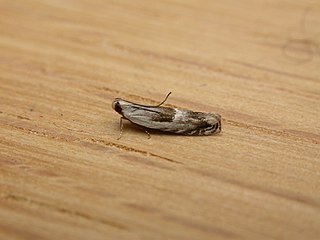Sarotorna eridora is a moth of the family Gelechiidae. It was described by Edward Meyrick in 1904. It is found in Australia, where it has been recorded from New South Wales.

Epibrontis hemichlaena is a moth in the family Gelechiidae described by Oswald Bertram Lower in 1897. It is found in Australia, where it has been recorded from Queensland, New South Wales, Victoria, the Australian Capital Territory, South Australia, Western Australia and Tasmania.
Idiophantis insomnis is a moth of the family Gelechiidae. It was described by Edward Meyrick in 1904. It is found in Australia, where it has been recorded from New South Wales.
Procometis hylonoma is a moth in the family Autostichidae. It was described by Edward Meyrick in 1890. It is found in Australia, where it has been recorded from New South Wales, Victoria, and South Australia.
Procometis lipara is a moth in the family Autostichidae. It was described by Edward Meyrick in 1890. It is found in Australia, where it has been recorded from New South Wales.
Procometis monocalama is a moth in the family Autostichidae. It was described by Edward Meyrick in 1890. It is found in Australia, where it has been recorded from New South Wales.
Lecithocera imprudens is a moth in the family Lecithoceridae. It was described by Edward Meyrick in 1914. It is found in Australia, where it has been recorded from New South Wales and Queensland.
Chalarotona craspedota is a moth in the family Xyloryctidae. It was described by Edward Meyrick in 1890. It is found in Australia, where it has been recorded from New South Wales, South Australia and Victoria.
Phthonerodes is a genus of moths of the family Xyloryctidae.
Xerocrates is a monotypic moth genus in the family Xyloryctidae. Its only species, Xerocrates proleuca, is found in Australia, where it has been recorded from South Australia, Victoria and Western Australia. Both the genus and species were first described by Edward Meyrick in 1890.
Clerarcha dryinopa is a moth in the family Xyloryctidae. It was described by Edward Meyrick in 1890. It is found in Australia, where it has been recorded from the Australian Capital Territory, New South Wales and Victoria.
Crypsicharis neocosma is a moth in the family Xyloryctidae. It was described by Edward Meyrick in 1890. It is found in Australia, where it has been recorded from New South Wales, the Northern Territory, Queensland and Western Australia.
Cryptophasa rubra is a moth in the family Xyloryctidae. It was described by Edward Meyrick in 1890. It is found in Australia, where it has been recorded from South Australia, Victoria and Western Australia.
Pilostibes stigmatias is a moth in the family Xyloryctidae. It was described by Edward Meyrick in 1890. It is found in Australia, where it has been recorded from New South Wales and Queensland.
Lichenaula arisema is a moth in the family Xyloryctidae. It was described by Edward Meyrick in 1890. It is found in Australia, where it has been recorded from New South Wales, South Australia and Victoria.
Lichenaula choriodes is a moth in the family Xyloryctidae. It was described by Edward Meyrick in 1890. It is found in Australia, where it has been recorded from New South Wales and Queensland.
Lichenaula laniata is a moth in the family Xyloryctidae. It was described by Edward Meyrick in 1890. It is found in Australia, where it has been recorded from New South Wales and Queensland.
Lichenaula musica is a moth in the family Xyloryctidae. It was described by Edward Meyrick in 1890. It is found in Australia, where it has been recorded from South Australia, Victoria and Western Australia.
Xylorycta melanula is a moth in the family Xyloryctidae. It was described by Edward Meyrick in 1890. It is found in Australia, where it has been recorded from New South Wales.
Xylorycta micracma is a moth in the family Xyloryctidae. It was described by Edward Meyrick in 1890. It is found in Australia, where it has been recorded from New South Wales, Queensland and Tasmania.
